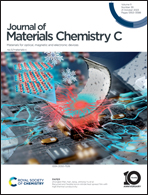Ultrahigh breakdown strength and discharge energy density of newly designed asymmetric sandwich-structured PVDF-based nanocomposite film†
Abstract
Poly(vinylidene fluoride) (PVDF)-based composite materials with high discharge energy density (Ue) represent a compelling option in the quest for high-performance dielectric capacitors. However, the existing PVDF-based composite materials are limited by their low breakdown electric field (Eb) and cannot satisfy the use of capacitors in extreme environments of ultrahigh voltages. Designing multilayer composite structures is a successful strategy to enhance the maximum Eb and Ue of PVDF-based composite films. In contrast to the traditional symmetric laminated structure, this paper innovatively proposes an asymmetric sandwich-structure PVDF-based nanocomposite film fabricated via the casting method, which is composed of a breakdown guiding layer with 0D BT powders, a breakdown buffer layer of P(VDF-HFP), and a breakdown cut-off layer with 2D BN nanosheets. The improved structure has significantly boosted the energy storage characteristics of the nanocomposite film. Specifically, adding 5 vol% 2D BN nanosheets to the breakdown cut-off layer enables the film to achieve an outstanding Ue of 22.72 J cm−3 at an extremely high Eb of 720 MV m−1. Finite element simulation provides support for the breakdown mechanism of the nanocomposite film. Ultimately, this study presents a novel strategy for the preparation of advanced dielectric capacitor materials.



 Please wait while we load your content...
Please wait while we load your content...